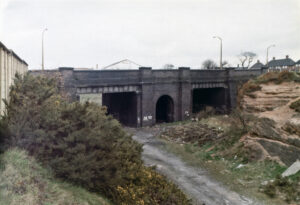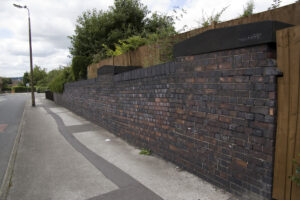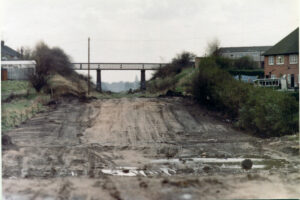As we near the end of this year’s Shadows & Reflections run, Ian Preece looks back on a 2023 of learning about the Leen Valley, attempting to age with dignity, and reading books in the bath.

My 24-year-old daughter had been to a dub night on an industrial estate in Walthamstow with her brother. It was only sitting next to her on the tube the following day that I realised her jacket completely reeked of weed. As we approached the away-end turnstiles at Stamford Bridge I saw the police dog first and made a beeline for it. Dogs aren’t stupid, though – it shot around me and was all over Edie in a flash. After twenty minutes in the holding cell, the body search, and having convinced the authorities that no, she wasn’t planning on heading into a Premier League ground with a huge stash, the steward escorted Edie back round the queue and into the stadium, before nodding at me and saying to her, ‘You can meet your granddad [??!] the other side . . .’ This, on the back of being in our local branch of Iceland a few days beforehand, and, having arrived at the self-service till, the security guard glided over, scanned his card and gave me something like 16p discount on my frozen peas and McVities Digestive Creams. Outside there was a huge banner heralding Tuesday afternoon shopping for the over-60s: 10 percent discount.
I’m only 56 (55 at the time of the above incidents). Maybe it’s time to do away with the Brian McClair beard and (to steal a Geoff Dyer line) to dye my hair jet black. I remember reading a Will Oldham/Bonnie ‘Prince’ Billy interview somewhere, detailing his struggles to grow old gracefully while retaining some kind of dignity. Just this Christmas we were shopping in a cool Covent Garden clothes shop when I nodded and smiled at a former work colleague who I used to like/get on with, and tried not to look like someone on the dementia wing as I struggled to recall her name1, suddenly becoming consumed with studying ethically sourced t-shirts. At a festive party I embarrassingly mixed up jazz writers Brian Priestley and Brian Case; started reminiscing about a Julia Holter gig when I meant Julianna Barwick; bought my son the Nairobi Sisters’ 7-inch ‘Promised Land’ which, now I come to think of it, yes, I do remember him playing in the kitchen, back in the summer, just after he’d got it from Lion Vibes – before, in fact, I’d picked up a copy for myself; then, only the other morning, found myself placing my teabag in the saucepan that was heating up the porridge, rather than the mug2. At least this year I did not buy any member of my family a copy of The Ragged Trousered Philanthropists (we have three copies now, accumulated over recent Christmases).
It could just be getting old: I’ve reached saturation on my bandwidth. When you’re surrounded by (and keep adding to) the fruits of a lifelong vinyl addiction it’s hard to remember the exact running order of Bowery Electric’s Beat or if Dub from the Roots came before or after The Roots of Dub in King Tubby’s discography. But the problem lies, I think, with the digital world. The internet, endless news feeds, scrolling on Twitter, texts from the milkman, texts from the bank, emails detailing yet another ‘essential 45 – don’t sleep’; emails with headings like ‘Waltham Forest: Christmas Bin Dates’ . . . information isn’t slowly digested any more, knowledge gently accrued following immersive reading and lived experience – it’s shot out of a water cannon in a high-velocity jet. You’re soaked, not much of it really goes in, and the damp just corrodes what was already there.
Aside from some kind of revolution, the answer, I think, lies in peeling all this back, returning to a simpler time and way of being; a bit of depth at the expense of the surface covered. I’ve finally ditched the Guardian for the London Review of Books; I try to read more of my book every morning in the bath – rather than endless LP reviews in myriad music magazines. ‘Of all the ways in which self-knowledge may be fostered,’ writes Annie Ernaux in The Years, ‘perhaps one of the greatest is a person’s ability to discern how they view the past, at every time of life and every age.’ I’ve become slightly obsessed with the locale of my roots; my endz. I’ve morphed into one of those people standing by the rotating Tempus Publishing carousel in the supermarket or petrol station (if they had them any more), picking up Images of Sport: Third Lanark Athletic Club or Leyton and Leytonstone in Old Postcards. As it is, I’m motoring through The Leen Valley at Work, 1785 to 1985 by Martin R Weiss, soaking up a world where frame knitting and cotton mills, from Papplewick to Nottingham, came to be replaced by pits and railways, and the northern suburbs of the city, like Bulwell and Basford, grew as railway workers and miners moved to the area. In amongst those were my mum’s parents: well, my granddad was born in Basford anyhow, but couldn’t stand the enclosed tedium of working on a machine, making stockings in a hosiery factory by the River Leen once he’d left school at 14 in 1923 – for him the freedom of the footplate beckoned, first as a fireman then as a train driver on the Great Northern line, based at Annesley Sheds, ferrying coal, aggregate and goods to and from places like Newstead, Renishaw, near Sheffield and Mexborough near Rotherham, then back south through Lindby, Hucknall, Bestwood and Bulwell Common, where my mum used to place half-pennies on the line which, if positioned just right, the steam train would flatten into a full penny that could then be slotted in the Wrigley’s chewing-gum machine fixed to the wall outside the newsagent’s on Highbury Vale. After practically a whole working life on the railway, my granddad, a quiet but proud man, lost his job during the Beeching cuts. He died of cancer three years later in 1968. The whole web of lines north of Nottingham was ripped up, embankments levelled, cuttings filled in. Coming across Graham Woodward’s excellent photos from 1979 online (shots of and from Kersall Drive bridge featured here) was something of a madeleine – post-industrial wasteland was baked in from an early age, I guess. By the time I was a teenager cycling round there on my Raleigh 14 much of the evidence of the railways had gone. An estate of bungalows had been built over the tracks where Stanley, in his Great Northern cap, oversized denim work jacket, shirt and tie underneath, used to descend the steps every day to catch the Dido (‘Day In Day Out’ train) that took him to Annesley Sheds. But I always remember being entranced by the blue/black-brick bridges that bookended Bulwell Common station and over time became sunk deep into the earth, their parapets still visible, one by the car park to the Golden Ball pub, the other carrying traffic down Kersall Drive (where Stanley and his wife Hilda had set up family life in a small council house in 1935). From an early age I wanted to travel back to a time when steam trains would thunder underneath them.


What I can remember is what Martin Weiss, when discussing the local brewery, Shipstone’s, describes as the ‘combined aroma of brewery, gas works and soap factory, something which added to the character of this part of the district’. Hanging about on the left-wing for Southwark Street Juniors, habitual basement dwellers of Division 9 of the Nottingham District Schools League, we sometimes played other school teams on football pitches by the soap works the other side of the Leen – teams full of even harder kids from Basford Flats. Those pitches were dug up in the eighties having been found to be full of toxic chemicals – my dad sent me a newspaper cutting from the Nottingham Evening Post (I wish I could find that now). Basford Flats were demolished in 1985.
New Basford, the gas works, Shippo’s, where the brewery once was and the tram now grinds past the front windows of brick terraces – that neck of the woods heading into Radford and Lenton is Alan Sillitoe territory, the streets of Saturday Night, Sunday Morning. ‘Nottingham: I hadn’t seen it for some time, and the word came like a shock, bringing a sudden clear vision of packed streets and factory chimneys, of tar melting between cobblestones in summer, of riotous public houses on Saturday night,’ wrote Sillitoe in 1975, reflecting on how he came to write his name-making novel after living in Majorca and France for a good while. He was also a firm believer in tracing it all back to the source: ‘The events which a writer sees in his life as important may seem irrelevant to other people. Probably the most vital things happened to him before he even wrote his first few pages, and meant more to him than anything he will ever write.’ Gendered pronouns of the time notwithstanding, reading Alan Sillitoe’s The Long Piece and Stanley Middleton’s Bulwell3 have probably given me the greatest blast of no-nonsense prose this last year. Middleton, who (slightly astonishingly from the modern-day perspective of having taught for much of his life in High Pavement college, near the Green Barrel pub on the Bestwood Estate, something of a rough establishment burnt down by local yobs a few years ago) won the Booker Prize in 1974 for the admirably gloomy Holiday. Middleton was Bulwell born and bred and ends his 1981 eulogy, Bulwell, up on the common among the gorse, harebells and silver birches, recalling childhood days sledging and being up there at night in winter, ‘when the wind shredded clouds across the moon, and smoke blew and shifted from every chimney down in the valley, over the viaduct, the factories, the black humps of the chapels, slate roofs wet and shining. Here was a place fit to walk, scarfed, and look out over the railway line to London, and nurse ambition.’
____
1Hi, Sophia, hope life is good.
2Note to any publishers who employ me as a freelancer: please be reassured I retain laser-like focus with zero tolerance for repetition within the confines of the manuscript I’m editing – it’s just everyday life that is proving difficult . . .
3Both in short books/pamphlets from the excellent Five Leaves Bookshop/publisher in Swann’s Yard, off Long Row, by the Council House.
*
Thanks to Graham Woodward for use of his photographs. Plenty more shots can be found at http://www.gwoodward.co.uk/